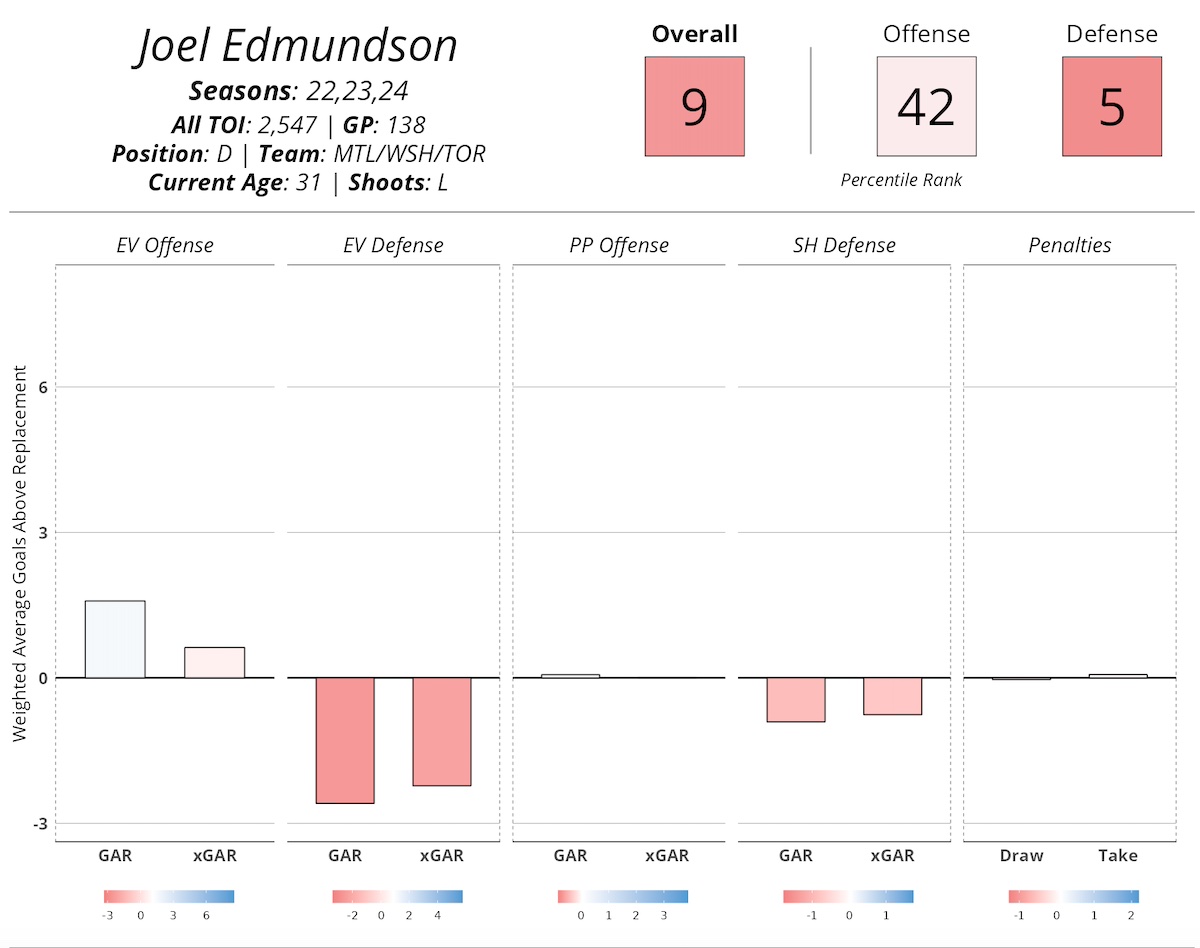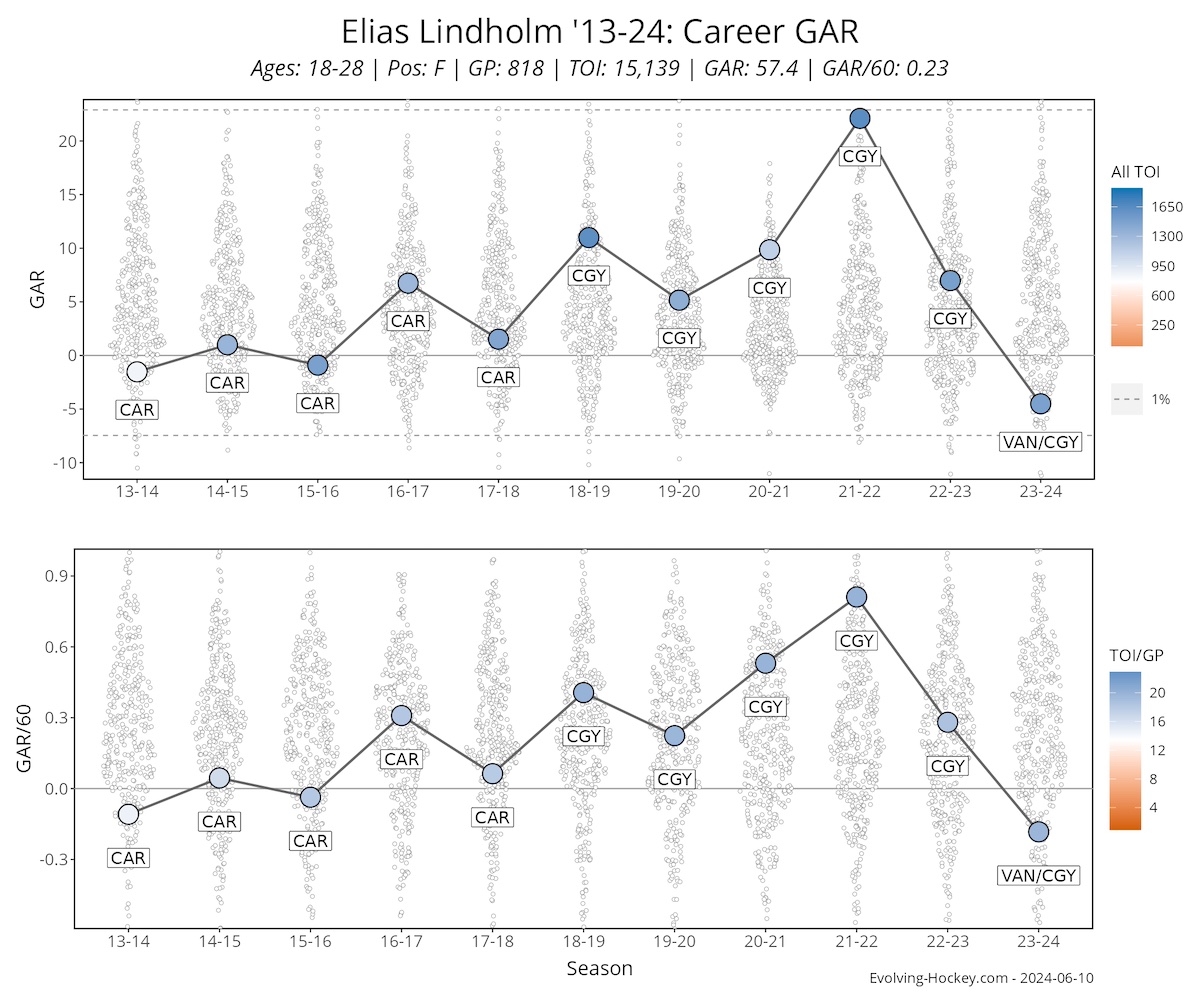The last big-name free agent for the 2024 offseason went off the board after Vladimir Tarasenko signed a two-year deal with the Detroit Red Wings. That means we can now safely look at the best and worst UFA contracts handed out this summer, and there were plenty of them. While some NHL teams seem to be getting smarter in free agency, there were still some pretty questionable contracts handed out in the first week of free agency. Let’s look at the eight worst.
Brady Skjei
I’m not sure anyone was prepared for the spending spree the Nashville Predators went on in free agency, but did they ever hand out plenty of money on July 1. They had a couple of candidates for the worst UFA contracts of 2024, but Brady Skjei’s seven-year deal at a cap hit of $7 million was the most egregious of what general manager Barry Trotz handed out.
Related: 2024 NHL Free Agency Tracker
It’s not that Skjei is a bad player. In fact, it’s quite the opposite. He finished this past season with a career-high 13 goals and 47 points in 80 games for the Carolina Hurricanes. A 7×7 deal is in line with what he projected to sign for this summer.
However, there are some red flags with signing Skjei to a seven-year deal. One) He turns 31 in March, so seven years for a defenseman on the wrong side of 30 could be problematic. Two) How will he fare outside the Hurricanes’ system since it’s a defenseman’s dream? Andrew Brunette’s system should cater well to an offensive defenseman like Skjei’s, but it’s not guaranteed. We’ll see how his contract ages, but history is not on the Predators’ side.
Joel Edmundson
If you’re confused by what the Los Angeles Kings are doing, welcome to the club. Not every move they made this summer was terrible; adding Warren Foegele to the roster should help. But transactions like signing Joel Edmundson to a four-year deal at a cap hit of $3.8 million will hinder their progress and keep them the 16th-20th best team in the NHL.
Edmundson once had the reputation of being a stout defensive defenseman, but that has changed drastically in recent seasons. His game has taken a steep dive, specifically defensively. His even-strength defense has been worth a goals above replacement (GAR) of minus-7.7 over the last three seasons, and his GAR/expected GAR player card shows his best days are behind him:

A $3.8 million cap hit isn’t the worst, but that’s money you pay someone who could play second-pair minutes. Edmundson is not a top-four defenseman anymore, and the term is particularly problematic. It’s reminiscent of the Columbus Blue Jackets signing Erik Gudbranson to a four-year deal at a cap hit of $4 million, and we know how that’s worked out for the Blue Jackets.
Chris Tanev
The Toronto Maple Leafs have had their eye on Chris Tanev for quite some time. That’s probably not a surprise since former Calgary Flames GM Brad Treliving is now the Maple Leafs’ GM, and he got what he wanted when he signed Tanev in free agency. It did not come cheap, though, as Tanev inked a six-year deal at a cap hit of $4.5 million.
A $4.5 million cap hit is fine for Tanev. He’s still one of the best defensive defensemen in the NHL, but six years could cause problems. Tanev is 34 and plays a bruising style of hockey that could lead to a precipitous decline at any time. Even with the salary cap projected to rise to $100 million in a couple of years, you don’t want to burden yourself with problem contracts, and Tanev signed for six years will likely cause problems at some point.
Chandler Stephenson
The Seattle Kraken needed to add more scoring pop to their lineup this offseason, but they had an interesting way of going about it. Chandler Stephenson seems like a fine fit for what they need, but signing him to a seven-year deal at a cap hit of $6.25 million may have arguably been the worst contract handed out in free agency this year.
Stephenson was a productive player for the Vegas Golden Knights over the last few seasons, but he struggled mightily in 2023-24, despite what his 51 points might say. Though his skating still looks good, many of the things Stephenson usually does well dropped off dramatically. He struggled in transition, and his shot metrics fell off a cliff.
Perhaps it was just a down year for Stephenson, but even if it was, the Kraken paid him like a first-line center. Even when he’s at his best, he’s a second-line pivot, so they’re unlikely to find value for him. And if his 2023-24 season was the sign of something worse and he’s beginning to decline, the Kraken will find themselves in big trouble with this contract sooner rather than later.
Elias Lindholm
Elias Lindholm was always heading toward one of the worst UFA contracts handed out this summer, and the Boston Bruins delivered. He signed a seven-year deal at a cap hit of $7.75 million and is coming off a down season that saw him total just 15 goals and 44 points in 75 games between the Calgary Flames and Vancouver Canucks.
Players have down seasons all the time, and sometimes, their underlying numbers suggest a rebound is in store. That is not the case with Lindholm, though. Not at all. There’s been a steep, steep decline in his game since he had a 40-goal and 80-plus point season in 2021-22, one that’s more than concerning:

The more and more you look at Lindholm’s 2021-22 season, the more and more it looks like Matthew Tkachuk and Johnny Gaudreau carried him on that line. If there’s a silver lining for the Bruins, they’ll likely pair Lindholm with David Pastrnak, one of the best play-driving wingers in the NHL. Still, this contract seems rich for Lindholm and may cause the Bruins more headaches than anything else.
Sean Monahan
Sean Monahan was a feel-good story this past season and got the payday he deserved. After struggling with serious injuries for multiple seasons, he played in 83 games between the Montreal Canadiens and Winnipeg Jets, finishing with 26 goals and 59 points, his best scoring output since 2018-19 when he posted 82 points with the Flames.
Monahan had one of his most valuable seasons in quite some, too. His play was worth a total GAR of 9.7, so giving him a payday wasn’t unreasonable. The Blue Jackets’ reasoning for signing him makes sense as well. I’m sure they’re looking for someone who can spark Gaudreau, who has struggled in his two seasons with the Blue Jackets. Monahan and Gaudreau played well together with the Flames, so the rationale is understandable.
The $5.5 million cap hit for Monahan is tolerable, too. It’s the term that could be problematic with his contract, and it’s not about his talent. He showed this season that if he’s healthy, he’s still a top-six forward. But the injury history is long, and giving him five years comes with a fair amount of risk. If he can’t stay healthy moving forward, the Blue Jackets could have another problem contract on their hands, and they don’t need another as they try to work their way out of their rebuild.
Jake DeBrusk
The Canucks have a history of handing out some questionable contracts, but I’ll admit, they’ve done worse than giving Jake DeBrusk seven years. I’ll also admit that I had a tough time with this one because I think I understand what the Canucks were trying to do by giving him seven years. They wanted to keep his AAV down.
They succeeded in that regard, as DeBrusk signed at a cap hit of $5.5 million. Evolving Hockey had him signing at a cap hit of just over $6.2 million on a seven-year deal, so the Canucks got some value here. Still, term is always the killer in free agency and not so much cap hits. DeBrusk is a good player, but we’ve seen how seven-year deals have gone for second-tier free agents in the past.
DeBrusk has averaged 49 points per 82 games over the last three seasons, so he will give them middle-six production. Is that the type of player you give a seven-year deal? For me, it isn’t. But the Canucks are banking on keeping the AAV down and a rising cap making it less of a problem contract down the road. Will that be the case? History suggests no, but time will.
Brandon Montour
Finally, there’s the second seven-year contract that the Kraken handed out on July 1. Signing Brandon Montour to a seven-year deal worth north of $7 million wasn’t as much of a surprise as Stephenson. But it’s still a curious decision for a franchise as analytically inclined as the Kraken are.
Montour is an interesting player in that he didn’t break out until later in his career when he joined the Florida Panthers. He totaled a career-high 73 points in 80 games two seasons ago and produced at a 41-point pace last season. He’s an offensively gifted defenseman who creates plenty of in-zone offense and excels at moving the puck. The Kraken could use more of that in their lineup, but he’s now the team’s second-highest-paid player behind Vince Dunn.
Is Montour that good? Can he handle top-pair minutes? Montour thrived in Florida because the Panthers gave Aaron Ekblad the difficult defensive minutes, allowing him to play an offensive role suited for him. The Kraken are paying him to be more than a second-pair blueliner, and I don’t think he’s that. A three or four-year deal would’ve been perfectly acceptable for him, but seven years and a cap hit of $7.142 million seems rich. Including the Stephenson deal, the Kraken may have their hands tied with these two contracts in a couple of years.
Some Teams Still Making the Same Mistakes
Teams handed out a record-breaking amount of money in free agency this year, and these contracts are among ones that could become albatrosses in a few years. While some teams are getting smarter in their approach to July 1, some are still making the same mistakes and not learning from ones other organizations have made in the past.
* * *
Advanced stats from Evolving Hockey
